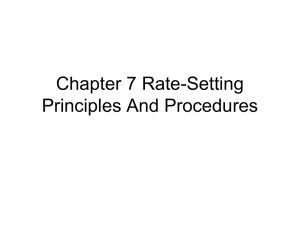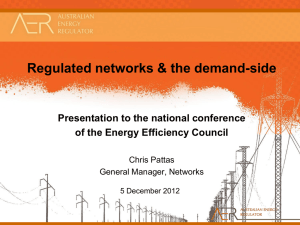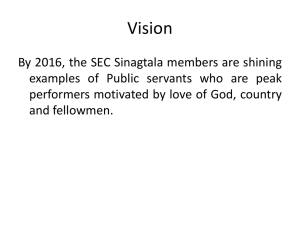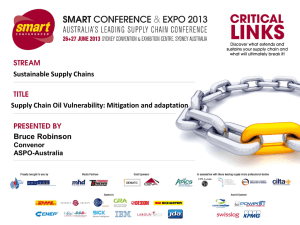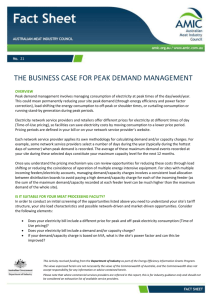How to reduce peak demand
advertisement
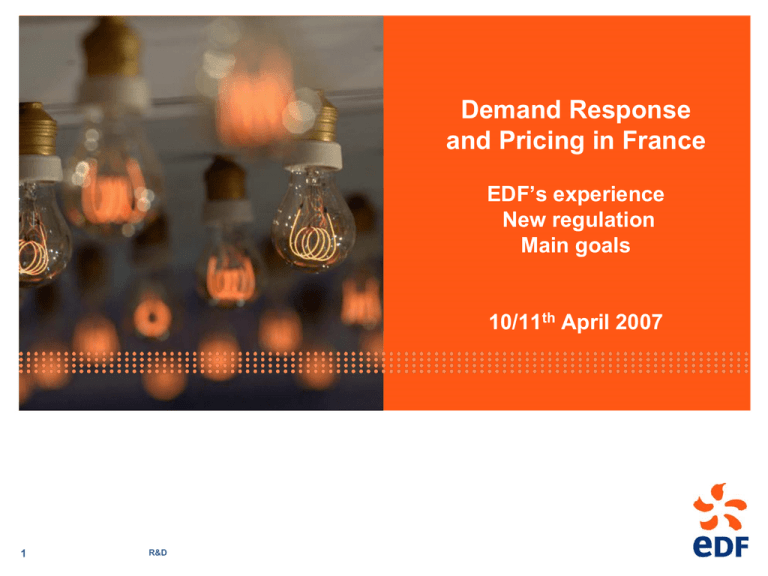
Demand Response and Pricing in France EDF’s experience New regulation Main goals 10/11th April 2007 1 R&D How to reduce peak demand: Already an old story in EDF’s tariffs Tariffs based on marginal cost of production (fixed part and variable part) Introduction of Time of Use tariffs : a fixed rate with different time units depending on hours and seasons - « Green tariffs » (1956) for large firms or buildings (La Defense): Many prices options according to season/hour and localisation/ use - « Off-peak hours » tariffs for residential market and business (1965) (10 PM to 6AM week days, Sundays) = 2,000 hours/summer ( + 2,000/winter) - « Peak day step back » (EJP) (1982) for residential market : reduce consumption at critical times (22 days of 18 hours between 1st November and 31th March) high price during this period –low price the rest of the year. Replaced by TEMPO (6 price’s levels according to hour and season– SMS or email signal) 2 R&D How to reduce peak demand: Already an old story in EDF’s tariffs Good results : « off-peak hours » tariffs reduce peak consumption by about 20% Customers with « Peak day stepping back » tariffs reduce their consumption by 50% during peak period (4% of total residential consumption) 3 R&D New regulation in France is stimulating DR • French Regulatory Energy Commission (CRE) : « Load reduction rules » for retail electricity market (Dec 07) in cooperation with : • Load management Providers : Voltalis, Ergelis • Energy Suppliers : EDF, GDF, Electrabel, Endesa France, Poweo, Direct energy • Distribution network : a subsidiary of EDF (ERD) • French Senate : “New metering associated to dynamic pricing for supply security” (June 07) • French Government (Environmental issue)* and Business Organisation (Medef) “Introduction of smart metering to reduce peak demand and develop competition” •Grenelle de l’environnement (September 2007) • Smart Metering development : 2010 –2015 : goal to replace all actual meters by new smart technology A tool for demand response (but not sufficient) 4 R&D Demand response : A new opportunity in the present situation Present situation Past situation • TOU pricing because of production constraint • Wholesale market (price volatility) : reduce peak price and market power • A global constraint (planned system equilibrium) • Local constraint: renewable energy integration (wind, biomass…) • Regulated tariffs (still exist) • A monopoly supplier • Retail prices are bound to change to take into account demand peak (dynamic pricing as default pricing ?) • Oligopoly and competition : new offers on bill decrease, automated home services … • Basic metering with limited communication • New technical progress : Smart metering (more interactive) interconnexion of electrical and telecom networks with AMR •CO2 reduction goals • Peak demand increasing strongly 5 R&D Peak Demand Increase in France due to retail market • 10 historical peaks in the last 7 years • Each new year brings a new record peak • Demand peaks : bigger and more often (even in summer) • Household consumption is responsible for global increase (increase of more than 75% since 1990) • … due to « brown product » use (electronic and communication e.g. : cell phone, computers…) Source : RTE (Transmission Network organisation) 6 R&D Goals of Demand Response • Reduce investment cost and operation cost (production, transmission) due to peak demand Past issues still exist • Cut down energy bill of consumers News Markets issues • Reduce price volatility and peak prices on wholesale markets (and limit market power of suppliers) • Improve the link between wholesale and retail markets • Develop competition and switching in retail market (customized new offers, new entrant…) • Develop renewable energy (solar, wind, biomass) : correlate News the consumer’s real consumption profile with production of Environet « green energy » issues • Reduce CO2 emissions (from coal or fuel power plants) R&D 7 Pricing with Demand Response : a link between the markets Wholesale market Retail market Fixed price contracts Procurement strategy Wholesale Price Reduce volatility and peak price Environmental pricing (External costs, CO2 emissions permits) 8 R&D Competitive strategy Wholesale Cost Retail Price Demand response pricing (Dynamic pricing, RTP, CPP…) Economy of Scale Economy of Diversity « Green Pricing »

